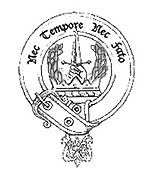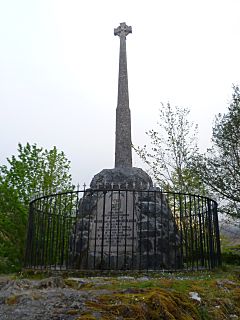Clan MacDonald of Glencoe facts for kids
Quick facts for kids Clan MacDonald of Glencoe |
|||
|---|---|---|---|
| Clann Iain Abrach | |||

Crest: a hand holding a sgian dhu surrounded by an open laurel wreath.
|
|||
| Motto | Nec Tempore Nec Fato (Neither Time Nor Fate) | ||
| Profile | |||
| Region | Scottish Highlands | ||
| District | Lochaber | ||
| Plant badge | Common Heath | ||
| Pipe music | Mort Ghlinne Comhann | ||
| Clan MacDonald of Glencoe has no chief, and is an armigerous clan | |||
|
|||
|
|||
The MacDonalds of Glencoe were a famous Scottish clan from the Scottish Highlands. They were also known as Clann Iain Abrach in Scottish Gaelic. This clan was a part of the larger Clan Donald.
They got their name from Glen Coe, a beautiful valley where they lived for many centuries. The MacDonalds of Glencoe were known for being very independent. They sometimes took cattle from other clans, which was a common practice in the Highlands.
Their history includes a very sad event called the Massacre of Glencoe in 1692. They also fought in the Jacobite uprisings of 1689, 1715, and 1745. These were attempts to bring the House of Stuart back to the throne of Britain.
The last chief of the clan passed away in 1889 without a child to take his place. Because of this, the clan does not currently have a chief recognized by the Lord Lyon King of Arms. This means they are considered an Armigerous clan.
Contents
History of the Clan
How the Clan Started
The MacDonalds of Glencoe are a branch of Clan Donald. Clan Donald is one of the biggest and oldest Scottish clans. Their story begins with a powerful leader named Somerled in the 1100s. He was a Norse-Gaelic warrior who became known as the "King of the Isles."
The MacDonalds of Glencoe are descended from Iain Fraoch MacDonald. He was a son of Aonghus Óg of Islay, a chief of Clan Donald. Aonghus Óg fought alongside Robert the Bruce during the First War of Scottish Independence. He was part of the famous Battle of Bannockburn in 1314, where the Scots won a big victory.
After this battle, Robert the Bruce gave Aonghus Óg lands, including Glen Coe. Aonghus Óg then gave Glen Coe to his son, Iain Fraoch. Iain Fraoch settled in this wild and beautiful valley. He became the first chief of the MacDonalds of Glencoe.
Life in the 16th Century
Life in Glencoe was often difficult. The land was not very fertile, so people sometimes had to find other ways to survive. This included taking cattle from other clans. While some people saw this as stealing, it was a common way of life for many Highland clans at the time.
During the 15th century, Clan Campbell started to become very powerful. They gained more land and influence, often at the expense of the MacDonalds. The Campbells became a strong force in Argyllshire. They did this by making smart alliances and gaining favor from the king.
The 17th Century and Clan Rivalries
The rivalry between the MacDonalds and the Campbells grew stronger in the 1600s. The Campbells gained more political power. During a period called the Wars of the Three Kingdoms, the Campbell leader, Archibald Campbell, 1st Marquess of Argyll, attacked MacDonald strongholds.
The MacDonalds of Glencoe often raided the lands of their Campbell rivals. One story tells of a time when the MacDonalds took cattle from the Campbells of Glenorchy. This happened during a wedding feast! The wedding guests had to stop celebrating and fight the invaders.
After a victory in the Battle of Killiecrankie, the MacDonalds of Glencoe took many cattle and valuables from Glenlyon. This left Robert Campbell of Glenlyon in a very difficult situation.
The Massacre of Glencoe
The Glencoe MacDonalds were known for being a bit wild and independent. They were one of several clans in Lochaber with this reputation.
In the late 1600s, the Scottish government wanted all clan chiefs to swear loyalty to the new King, William III of England. They set a deadline of January 1, 1692. If chiefs did not take the oath, they would face serious consequences.
The chief of Glencoe, Alasdair Ruadh MacIain MacDonald, was delayed by heavy snow. He arrived late to take the oath. Even though he eventually took it, the government decided to make an example of the Glencoe MacDonalds.
In the early hours of February 13, 1692, soldiers who had been staying with the MacDonalds attacked them. These soldiers were led by Robert Campbell of Glenlyon. This event is known as the Massacre of Glencoe. About 30 MacDonalds were killed. Others may have died from exposure in the cold.
Even though many people thought the MacDonalds were a "thieving tribe," the way the massacre happened was widely criticized. People were shocked that guests who had been welcomed into homes would then attack their hosts.
The 18th Century and Jacobite Uprisings
After the Glencoe massacre, the MacDonalds rebuilt their homes. But they continued to face difficulties from the British government. They remained loyal to the House of Stuart. This led them to join the Jacobite uprisings of 1715 and 1745.
The MacDonalds of Glencoe fought at the Battle of Sheriffmuir in 1715. Later, in 1745, their chief, Alexander MacIain MacDonald, led 130 men to support Charles Edward Stuart. They fought in many battles, including the final defeat at the Battle of Culloden.
After the 1745 uprising, the Highland clans faced harsh punishments from the British government. Many MacDonalds of Glencoe had to leave their homes. The traditional way of life in the Highlands changed forever.
The 19th Century and Decline
Over time, the Glencoe clan lost much of its power and influence. The last chief of the original Glencoe line, Alexander James MacDonald, passed away in 1889. He did not have a successor. This meant that the Glencoe branch of Clan Donald no longer had a recognized chief. They became an armigerous clan.
Clan Tartan
The tartan for the MacDonalds of Glencoe is often called MacIain/MacDonald of Glencoe. Sometimes it is confused with the MacDonald of Ardnamurchan tartan. However, there is a distinct tartan specifically for Glencoe. This special tartan is very old. It was found on bodies that were moved for burial in the 1800s. This shows that it was used long before the Highland Clearances.
List of Clan Chiefs
Here is a list of the historical chiefs of the Clan MacDonald of Glencoe:
- Iain Og an Fraoch MacDonald, 1st of Glencoe (born around 1300 – died 1358)
- John MacIain MacDonald, 2nd of Glencoe (before 1358)
- John MacIain MacDonald, 3rd of Glencoe
- John MacIain MacDonald, 4th of Glencoe
- John MacIain MacDonald, 5th of Glencoe
- John MacIain MacDonald, 6th of Glencoe
- John MacIain MacDonald, 7th of Glencoe
- Iain Og MacIain MacDonald, 8th of Glencoe (1543 – around 1590)
- Iain Og MacIain MacDonald, 9th of Glencoe (1579–1610)
- Iain Abrach MacDonald, 10th of Glencoe (died 1630)
- Alasdair Ruadh MacIain MacDonald, 11th of Glencoe (died 1650)
- Alasdair Ruadh MacIain MacDonald, 12th of Glencoe (1630–1692) (He was killed during the Massacre of Glencoe)
- John MacIain MacDonald, 13th of Glencoe (1657–1714)
- Alexander MacIain MacDonald, 14th of Glencoe (1708–1750)
- John MacIain MacDonald, 15th of Glencoe (around 1735 – 1785)
- Alexander MacIain MacDonald, 16th of Glencoe (1761–1814)
- Dr. Ewen MacIain MacDonald, 17th of Glencoe (1788–1840)
- Ronald MacIain MacDonald, 18th of Glencoe (1800–1841) (brother of the 17th chief)
- Alexander James MacDonald, 19th of Glencoe (1829–1889)
See also




